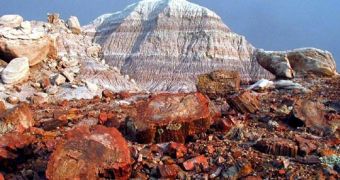One of the wonders of the American southwest is found in northeastern Arizona: an enormous petrified forest, a real geological treasure the scientists learned about to the end of the 19th century.
Petrified Forest National Park from Arizona comprises a surface of 218,533 acres (341.5 sq mi; 885 km?) of petrified wood, mostly of the coniferous species Araucarioxylon arizonicum, 170 million years old, since the Jurassic epoch. In some moment, whole forests were flooded. These conditions made the wood to get mineralized, turning into quartz, jasper and agate. Normally, the wood would have turned into coal. After that, the forest was covered by red and yellow sediments, which later were removed by wind and water.
This explains the preservation of the fossil wood and the large variety of colors some specimens exhibit. The red and yellow hues are the result of large particulate forms of iron oxide, the yellow being limonite and the red being hematite. The purple hue is caused by extremely fine spherules of hematite distributed throughout the quartz matrix.
The trunks did not grow there, but were carried by waters, which piled them, making deposits up to 50 m (160 ft) thick. But in this case, it was mineralized. For its exceptional beauty, the petrified wood was early exploited for making furniture, jewels and art objects. Large surfaces of the petrified forest were even dynamited.
In 1906, the area was declared National Monument (protected by law) and in 1962 its status was turned into National Park. With all the protective measures, the stealing of the fossil wood continued, the statistic confirming that annually 12 tonnes of the petrified wood are extracted illegally.
Araucarioxylon were trees 60 m (200 ft) high that measured more than 60 cm (2 ft) in diameter. Fossils frequently show boreholes of insects, as well as fossilized hives of prehistoric bees.
The genus Araucarioxylon is close or even synonymous to the modern genus Araucaria, which today is restricted to southern South America, Australia, New Caledonia, New Zealand and Norfolk Island.

 14 DAY TRIAL //
14 DAY TRIAL //